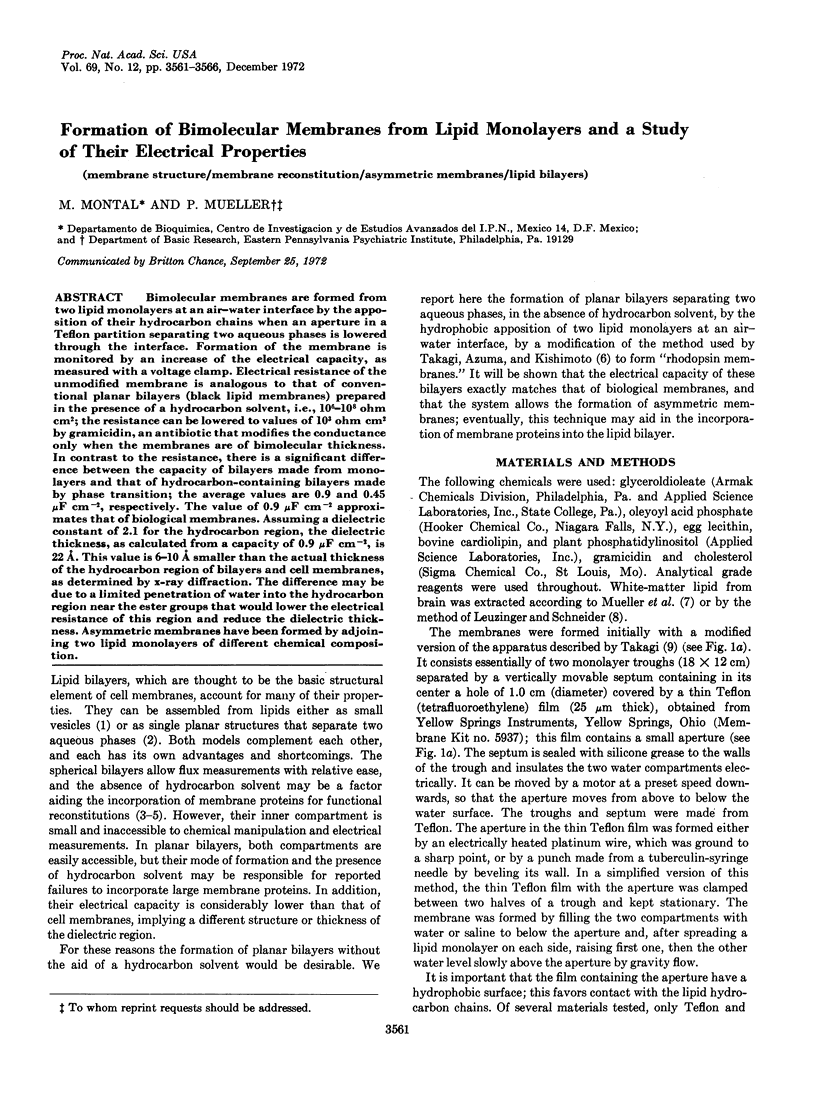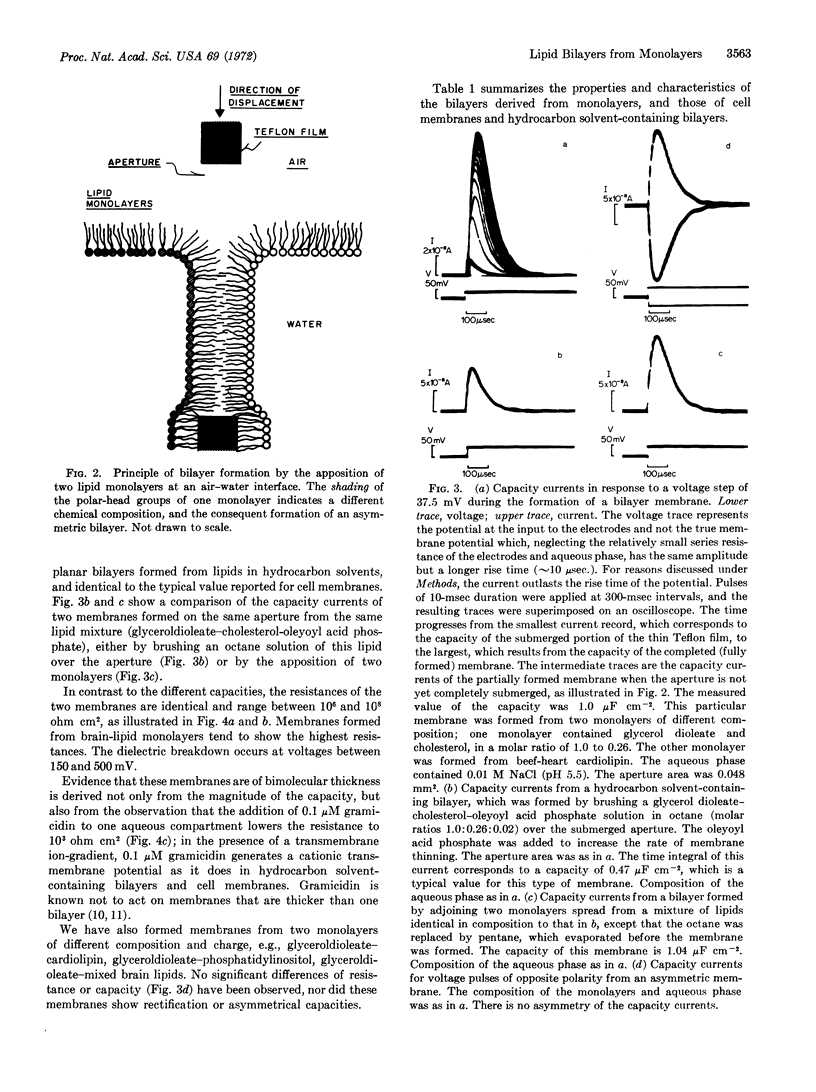Abstract
Bimolecular membranes are formed from two lipid monolayers at an air-water interface by the apposition of their hydrocarbon chains when an aperture in a Teflon partition separating two aqueous phases is lowered through the interface. Formation of the membrane is monitored by an increase of the electrical capacity, as measured with a voltage clamp. Electrical resistance of the unmodified membrane is analogous to that of conventional planar bilayers (black lipid membranes) prepared in the presence of a hydrocarbon solvent, i.e., 106-108 ohm cm2; the resistance can be lowered to values of 103 ohm cm2 by gramicidin, an antibiotic that modifies the conductance only when the membranes are of biomolecular thickness. In contrast to the resistance, there is a significant difference between the capacity of bilayers made from mono-layers and that of hydrocarbon-containing bilayers made by phase transition; the average values are 0.9 and 0.45 μF cm-2, respectively. The value of 0.9 μF cm-2 approximates that of biological membranes. Assuming a dielectric constant of 2.1 for the hydrocarbon region, the dielectric thickness, as calculated from a capacity of 0.9 μF cm-2, is 22 Å. This value is 6-10 Å smaller than the actual thickness of the hydrocarbon region of bilayers and cell membranes, as determined by x-ray diffraction. The difference may be due to a limited penetration of water into the hydrocarbon region near the ester groups that would lower the electrical resistance of this region and reduce the dielectric thickness. Asymmetric membranes have been formed by adjoining two lipid monolayers of different chemical composition.
Keywords: membrane structure, membrane reconstitution, asymmetric membranes, lipid bilayers
Full text
PDF





Images in this article
Selected References
These references are in PubMed. This may not be the complete list of references from this article.
- Allen W. V., Ponnamperuma C. A possible prebiotic synthesis of monocarboxylic acids. Curr Mod Biol. 1967 Mar;1(1):24–28. doi: 10.1016/0303-2647(67)90017-2. [DOI] [PubMed] [Google Scholar]
- Blaurock A. E., Wilkins M. H. Structure of frog photoreceptor membranes. Nature. 1969 Aug 30;223(5209):906–909. doi: 10.1038/223906a0. [DOI] [PubMed] [Google Scholar]
- Bretscher M. S. Asymmetrical lipid bilayer structure for biological membranes. Nat New Biol. 1972 Mar 1;236(61):11–12. doi: 10.1038/newbio236011a0. [DOI] [PubMed] [Google Scholar]
- Cherry R. J., Chapman D. Optical properties of black lecithin films. J Mol Biol. 1969 Feb 28;40(1):19–32. doi: 10.1016/0022-2836(69)90293-9. [DOI] [PubMed] [Google Scholar]
- Dratz E. A., Gaw J. E., Schwartz S., Ching W. M. Molecular organization of photoreceptor membranes of rod outer segments. Nat New Biol. 1972 May 24;237(73):99–102. doi: 10.1038/newbio237099a0. [DOI] [PubMed] [Google Scholar]
- Engelman D. M. Surface area per lipid molecule in the intact membrane of the human red cell. Nature. 1969 Sep 20;223(5212):1279–1280. doi: 10.1038/2231279a0. [DOI] [PubMed] [Google Scholar]
- Engelman D. M. X-ray diffraction studies of phase transitions in the membrane of Mycoplasma laidlawii. J Mol Biol. 1970 Jan 14;47(1):115–117. doi: 10.1016/0022-2836(70)90407-9. [DOI] [PubMed] [Google Scholar]
- Gitler C., Montal M. Thin-proteolipid films: a new approach to the reconstitution of biological membranes. Biochem Biophys Res Commun. 1972 Jun 28;47(6):1486–1491. doi: 10.1016/0006-291x(72)90240-9. [DOI] [PubMed] [Google Scholar]
- Goodall M. C. Thickness dependence in the action of gramicidin A on lipid bilayers. Arch Biochem Biophys. 1971 Nov;147(1):129–135. doi: 10.1016/0003-9861(71)90318-3. [DOI] [PubMed] [Google Scholar]
- HODGKIN A. L., HUXLEY A. F., KATZ B. Measurement of current-voltage relations in the membrane of the giant axon of Loligo. J Physiol. 1952 Apr;116(4):424–448. doi: 10.1113/jphysiol.1952.sp004716. [DOI] [PMC free article] [PubMed] [Google Scholar]
- Hendrickson H. S., Scattergoot E. M. The action of phospholipase C on black film bilayer membranes. Biochem Biophys Res Commun. 1972 Mar 10;46(5):1961–1969. doi: 10.1016/0006-291x(72)90077-0. [DOI] [PubMed] [Google Scholar]
- Hinkle P. C., Kim J. J., Racker E. Ion transport and respiratory control in vesicles formed from cytochrome oxidase and phospholipids. J Biol Chem. 1972 Feb 25;247(4):1338–1339. [PubMed] [Google Scholar]
- Jain M. K., Strickholm A., Cordes E. H. Reconstitution of an ATP-mediated active transport system across black lipid membranes. Nature. 1969 May 31;222(5196):871–872. doi: 10.1038/222871a0. [DOI] [PubMed] [Google Scholar]
- Kornberg R. D., McConnell H. M. Inside-outside transitions of phospholipids in vesicle membranes. Biochemistry. 1971 Mar 30;10(7):1111–1120. doi: 10.1021/bi00783a003. [DOI] [PubMed] [Google Scholar]
- Leuzinger W., Schneider M. Acetylcholine-induced excitation on bilayers. Experientia. 1972 Mar 15;28(3):256–257. doi: 10.1007/BF01928672. [DOI] [PubMed] [Google Scholar]
- Levine Y. K., Wilkins M. H. Structure of oriented lipid bilayers. Nat New Biol. 1971 Mar 17;230(11):69–72. doi: 10.1038/newbio230069a0. [DOI] [PubMed] [Google Scholar]
- Martonosi A. Sarcoplasmic reticulum. IV. Solubilization of microsomal adenosine triphosphatase. J Biol Chem. 1968 Jan 10;243(1):71–81. [PubMed] [Google Scholar]
- Mueller P., Rudin D. O. Development of K+-Na+ discrimination in experimental bimolecular lipid membranes by macrocyclic antibiotics. Biochem Biophys Res Commun. 1967 Feb 21;26(4):398–404. doi: 10.1016/0006-291x(67)90559-1. [DOI] [PubMed] [Google Scholar]
- Ochoa E., Fiszer de Plazas S., De Robertis E. Conductance changes produced by l-norepinephrine on lipid membranes containing a proteolipid from the bovine spleen capsule. Mol Pharmacol. 1972 Mar;8(2):215–221. [PubMed] [Google Scholar]
- Razin S. Reconstruction of biological membranes. Biochim Biophys Acta. 1972 Apr 18;265(2):241–296. [PubMed] [Google Scholar]
- Redwood W. R., Müldner H., Thompson T. E. Interaction of a bacterial adenosine triphosphatase with phospholipid bilayers. Proc Natl Acad Sci U S A. 1969 Nov;64(3):989–996. doi: 10.1073/pnas.64.3.989. [DOI] [PMC free article] [PubMed] [Google Scholar]
- Redwood W. R., Takashima S., Schwan H. P., Thompson T. E. Dielectric studies on homogeneous phosphatidylcholine vesicles. Biochim Biophys Acta. 1972 Feb 11;255(2):557–566. doi: 10.1016/0005-2736(72)90159-9. [DOI] [PubMed] [Google Scholar]
- Träuble H., Grell E. Carriers and specificity in membranes. IV. Model vesicles and membranes. The formation of asymmetrical spherical lecithin vesicles. Neurosci Res Program Bull. 1971 Jun;9(3):373–380. [PubMed] [Google Scholar]
- Wilkins M. H., Blaurock A. E., Engelman D. M. Bilayer structure in membranes. Nat New Biol. 1971 Mar 17;230(11):72–76. doi: 10.1038/newbio230072a0. [DOI] [PubMed] [Google Scholar]



